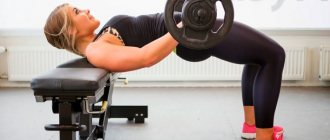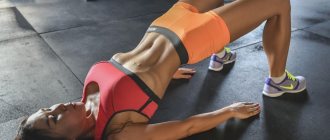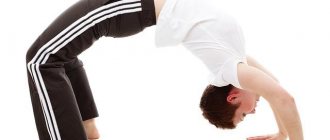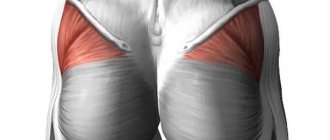Advantages and disadvantages
Let's start with the benefits of exercise:
- Allows you to work out the gluteal muscle group on each side in detail, visually improve the buttocks and increase the load even for trained athletes.
- Trains stabilizer muscles more effectively, which are activated when the body is in an unstable position. These include: thigh muscles - flexors and extensors, rectus and oblique abdominal muscles, lumbar extensors.
- Involves even more slow and fast muscle fibers by increasing the complexity of technique and balance.
What could be the disadvantages :
- This physically demanding exercise will be difficult for beginners, especially when it comes to keeping the pelvis in a level position and stabilizing the muscles. That is, the muscles simply will not be able to perform the movement correctly and get the effect.
- There is also a high risk of injury, which consists of a possible fall due to loss of balance, depending on variations in technique, overexertion and lower back pain.
- If the load is received unevenly, there is a risk of asymmetrical muscle toning.
Technique for performing on the floor
- Lie on your back, bend one leg at the knee and place your foot on the floor closer to your pelvis. Raise your other leg up. To make this option easier, you can lower the leg onto the supporting one, placing the ankle in front just below the kneecap. The arms lie along the body.
- Feel the support of your foot; when moving, it is important not to twist your pelvis or spine. The pelvic bones should move in the same plane, that is, one side should not sag.
- Exhale, pushing off with the heel of your supporting leg, lift your pelvis, trying to line up your spine and hips. The free leg remains in place and reaches towards the ceiling. It is important to tense not only the gluteal muscle, but also the abs, in order to prevent excessive arching in the lower back and not twisting the hip joint.
- As you inhale, slowly return your pelvis to the floor and continue.
- After completing the required number of repetitions, change legs.
Light version
Benefits of the gluteal bridge
Lifting your buttocks from a supine position is a variation of the bridge movement. But, unlike the bridge, it does not load the spine.
Working muscles.
Among its advantages are the following:
- Raising the pelvis perfectly loads the gluteus maximus muscles, additionally working the hamstrings (back muscles).
- No additional equipment is required to perform the exercise. A gymnastics mat is enough for you. You can do it at a convenient time at home.
- Lifting the pelvis from a lying position is one of the safest exercises for working the buttocks. It can be safely performed by people who do not have significant physical training, as well as teenagers, children and even pregnant women. In the latter case, the intensity of the load should be reduced by reducing the number of repetitions. It is also recommended to carefully monitor your condition, and if the slightest discomfort occurs, immediately stop exercising.
- In addition, the bridge is a familiar and simple exercise that everyone knows from a school physical education course. Therefore, lifting the buttocks from a supine position can be considered ideal for fitness beginners who are not too confident in their abilities, but want quick results.
Please note that the gluteal bridge is an isolating exercise. For this reason, it is advisable to perform it as part of a comprehensive lower body workout or combine it with aerobic exercise (if your goal is fat loss).
https://www.youtube.com/watch?v=IQQnTb7jrQg
Like any other exercise, lifting the pelvis should be done only after pre-warming the muscles. If you do it alone, add 4-5 minutes of jogging in place or any other moderate-intensity movement as a warm-up. Although, as mentioned above, it is recommended to do it after basic exercises.
Variants of the gluteal bridge on 1 leg
- In order to increase the load, you can use leg cuffs.
- The second option is an elastic band or ring, which should be placed on one side on the hip joint, and the other side should be fixed with the feet. The tighter the tape or the degree of its tension, the greater the load.
- Also, to increase the instability of the exercise and involve more muscle fibers, the supporting leg can be placed on an unstable surface, such as a barefoot or a balancing platform. You can also take a regular platform, even books or boxes, to increase the range of motion without compromising your balance.
- The next option is to use a fitball. In this case, the situation changes a little, but the essence remains the same. The supporting leg is placed on top of the ball and touches the shin, while the other leg is held vertically. The task is the same - to lift the pelvis up without losing balance.
- And another, more extreme option is to use two benches. The shoulder blades are placed on one bench, and the feet are placed on the second. In this case, the distance should be such that the knees are bent, as in the version on the floor. Then do the same: one leg rises up. With exhalation, the pelvis, due to the buttocks, rises above the level of the benches, and as you inhale, it slowly returns, falling slightly below the level of the hill. The difficulty is that the muscles do not relax during the entire approach, since they do not come into contact with a stable surface, and the amplitude increases.
Important: the last option is only for those prepared!
One leg bridge
The glute bridge is an effective exercise for working the muscles of the buttocks. By performing this functional multi-joint movement, you can pump up the following muscle groups:
- Buttocks. The exercise involves all 3 gluteal muscles: large, medium and small. It is this group that receives the maximum load.
- Core muscles. A group of muscles (oblique and transverse abdominal muscles, hamstrings, adductors) is responsible for muscle activity and stabilization of the entire body.
- Low back, or spinal extensor muscles.
Read: How to warm up before training
We recommend reading: Bent-over fly with dumbbells
Gluteal bridge 8 options
| Exercises | Sets | Repetitions/Time |
| Bridge on the floor | 3 | 20 |
| On the floor with a rubber band | 3 | 15 |
| On the floor in static | 2 | 60 seconds |
| Smith machine bridge | 3 | 12 |
| Bridge on a bench with a barbell | 3 | 12 |
| Bridge raises on one leg | 3 | 15 |
| With feet on a hill (or steppe) | 4 | 10 |
| Lying bridge with knees brought together | 3 | 15 |
Glute bridge on the floor
Technique:
Lie with your back on the floor. Place your hands along your body, palms down. Bend your legs at the knees and place them at a distance of 30-40 cm from your butt, shoulder width apart. Inhale and lift your hips up, arching at the lower back. Exhale and lower your pelvis down
Important! Don't touch the floor with your buttocks.
How many:
3 sets of 20 reps.
To make things more difficult for yourself, use weights. Place a training plate or barbell on your thighs.
Read: Training programs for butt enlargement
Exercise options
Glute bridge with elastic band or rubber band
You can use a rubber band to make it more difficult for yourself. To do this, you need to fold it in half and pass it over the pelvis. And fix the ends on a fixed surface or hold them with your hands. Do everything the same as in the classic version. Try to lift your pelvis as high as possible.
Performing the exercise in static conditions
In addition, you can use the static load option. In this case, you should hold the body at the top point for as long as possible. This way you can even use additional muscles in your back and legs.
We recommend reading: Which plank is more difficult on elbows or straight arms?
In the Smith machine
Technique:
- To begin, lower the bar of the machine to the level of the bench.
- Rest your back against the support. Bend your legs, press your feet to the floor.
- Place the pelvis under the simulator element: the bar must be removed from the supports.
- Exhale and lift your pelvis with the load. At the top point of the exercise, hold the position for a few seconds.
- Then slowly lower yourself down. During the exercise, you do not need to pause, lowering your pelvis to the floor.
Number of repetitions:
3 sets of 10 times.
Read: How to do a glute bridge in Smith
Glute bridge on a bench with a barbell
The exercise is performed similarly to the bridge in Smith. Instead of a simulator, we take a regular barbell. The movements in the exercise are more difficult in terms of complexity. You need to hold the barbell on your hips with your hands and concentrate on balance.
Bridge raises on one leg
Technique:
- Lie on your back. Bend one leg at the knee joint. Pull the other one up.
- Exhale and lift your pelvis off the floor. Stay for a while.
- Inhale and return to the starting position.
Repeat the exercise 3 times for 15 repetitions for each leg.
Read: How to do a glute bridge on one leg
With feet on a hill (or steppe)
Technique:
We recommend reading: Exercises with an elastic band for women at home
- Press your body to the floor.
- Bend both legs and place them on a bench or other small elevation. The heels of the feet must be pressed and secured.
- Inhale – lift your pelvis.
- Exhale - lower.
Do at least 4 sets of 10 repetitions.
Read: Exercises to pump up the buttocks
Technique:
- Lie down on the floor. The arms are located along the body.
- Bend your legs, place your feet at a distance slightly wider than your shoulders.
- As you exhale, lift your pelvis and bring your knees towards each other. Stay in this position, and then slowly return to the original position.
Perform 3 sets of 15 reps.
The glute bridge is a simple and effective exercise for the gluteal muscles. After all, as you can see, it can be performed both in the gym and at home. The main thing in achieving the desired result is the regularity of your training.
A simple and beautiful pole dance element that can also be performed as a stretching exercise.
How to do it. The simplest version of the exercise is performed lying with your back on the mat:
Calculate your ideal sports weight!
— Legs bent at the knees, head and shoulders pressed firmly to the floor throughout the entire exercise.
- Lift your buttocks up so that your body forms a straight line from your shoulders to your knees. Push your body forward with your feet.
- Squeeze your buttocks as much as possible at the top and hold. Raise one leg up and lock it in a tense position.
Mistakes to avoid. The hands are not under the shoulders, but far in front, the buttocks are relaxed.
Bridge on one leg. Instructor: Yulia Lushchikova.
How to implement it into training: recommendations
- Perform the exercise at the end of your leg workout. First, the muscles should be tired with complex multi-joint exercises, and then they can be “finished off” with a bridge on 1 leg.
- The number of repetitions, due to the complexity of the technique, can be significantly less than in the version on two legs, since the body weight is pushed not by both, but only by one side. Therefore, first of all, it is important not to lose the quality of the technique and perform as much as you can until you feel completely tired. Therefore, it is enough to perform approximately 10-20 repetitions on each side of 3 sets.
- After the exercise, it is necessary to stretch the gluteal muscles to relieve excessive tension in the muscles and prevent their stiffening.
- Perform the exercise 1-3 times a week, depending on the amount of leg training.
And also read: All options for the gluteal bridge →











